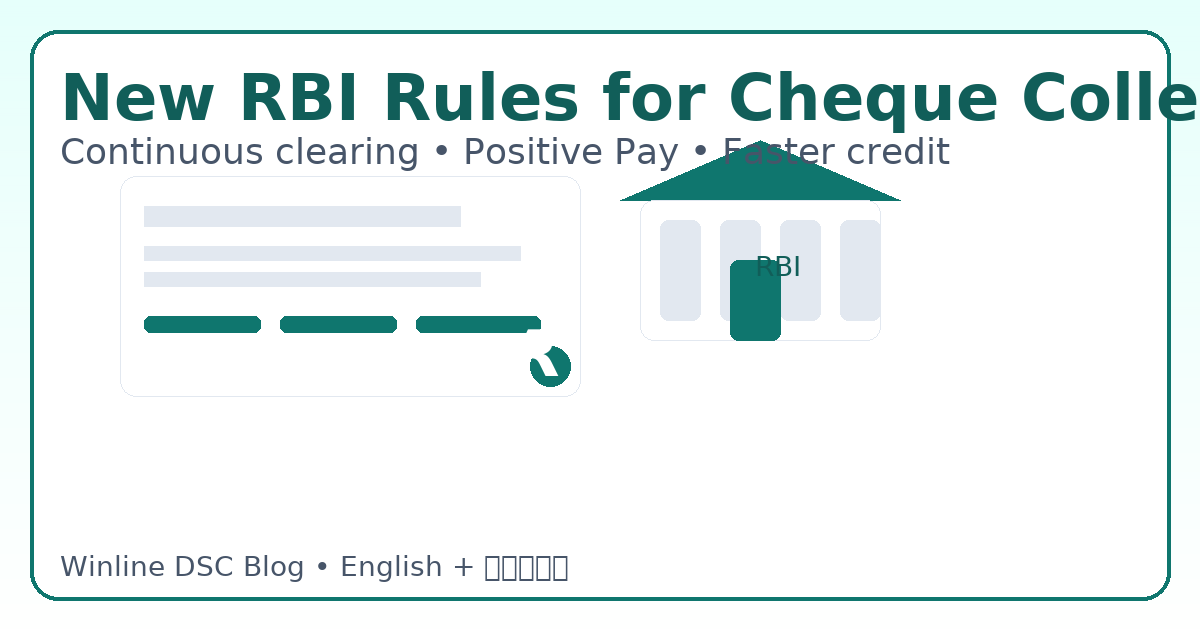Introduction
Cheques have been one of India’s most trusted payment instruments for decades. Even with the rise of UPI and digital banking, businesses, institutions, and individuals still rely on cheques for large-value transactions, official payments, and legal security. Recognizing this, the Reserve Bank of India (RBI) has introduced new rules to modernize cheque collection and make the process faster, safer, and more transparent.
Key Changes in Cheque Collection
- Continuous Clearing System: Cheques are processed continuously during banking hours, reducing batch-waits.
- Faster Credit: After clearance, funds must be credited quickly (often within an hour).
- Positive Pay: For cheques above ₹50,000 (mandatory for ₹5 lakh+ in many banks), issuers must pre-confirm details to curb fraud.
- Stricter Cut-offs: Deposits after daily cut-off move to the next business cycle.
- Compensation on Delays: If banks miss stipulated timelines, customers can claim compensation/interest per policy.
Why These Changes Matter
These reforms reduce uncertainty and accelerate fund availability. Businesses gain faster liquidity; fraud checks are strengthened via Positive Pay. Cheques become more competitive with digital payments.
Practical Tips for Customers
- Deposit cheques early in the day for same-day processing.
- Always register Positive Pay details for cheques above ₹50,000.
- Know your bank’s Cheque Collection Policy (cut-offs, timelines, compensation).
- In case of undue delay, lodge a complaint and seek compensation.
- Double-check cheque details (date, payee name, amount) before handing over.
Conclusion
The new rules modernize India’s cheque ecosystem. While UPI dominates daily payments, cheques remain vital for high-value and legal use-cases. With these reforms, cheques are poised to be faster, safer, and more reliable for everyone.
ಪರಿಚಯ
ಭಾರತದಲ್ಲಿ ಚೆಕ್ಗಳು ದಶಕಗಳಿಂದ ವಿಶ್ವಾಸಾರ್ಹ ಪಾವತಿ ಸಾಧನಗಳಾಗಿವೆ. ಯುಪಿಐ ಮತ್ತು ಡಿಜಿಟಲ್ ಬ್ಯಾಂಕಿಂಗ್ ಬೆಳವಣಿಗೆಯಾದರೂ ಸಹ, ದೊಡ್ಡ ಮೊತ್ತದ ವ್ಯವಹಾರಗಳು, ಅಧಿಕೃತ ಪಾವತಿಗಳು ಮತ್ತು ಕಾನೂನು ಭದ್ರತೆಗಾಗಿ ವ್ಯಾಪಾರಸ್ಥರು, ಸಂಸ್ಥೆಗಳು ಮತ್ತು ವ್ಯಕ್ತಿಗಳು ಚೆಕ್ಗಳ ಮೇಲೆ ಅವಲಂಬಿತರಾಗಿದ್ದಾರೆ. ಇದನ್ನು ಗಮನದಲ್ಲಿಟ್ಟುಕೊಂಡು, ಭಾರತೀಯ ರಿಸರ್ವ್ ಬ್ಯಾಂಕ್ (RBI) ಚೆಕ್ ಸಂಗ್ರಹಣೆಯ ಹೊಸ ನಿಯಮಗಳನ್ನು ಪರಿಚಯಿಸಿದ್ದು, ಪ್ರಕ್ರಿಯೆಯನ್ನು ವೇಗವಾಗಿ, ಸುರಕ್ಷಿತವಾಗಿ ಮತ್ತು ಪಾರದರ್ಶಕವಾಗಿ ಮಾಡಲು ಉದ್ದೇಶಿಸಿದೆ.
ಚೆಕ್ ಸಂಗ್ರಹಣೆಯ ಪ್ರಮುಖ ಬದಲಾವಣೆಗಳು
- ನಿರಂತರ ಕ್ಲಿಯರಿಂಗ್ ವ್ಯವಸ್ಥೆ: ಬ್ಯಾಂಕಿಂಗ್ ಅವಧಿಯಲ್ಲಿ ಚೆಕ್ಗಳನ್ನು ನಿರಂತರವಾಗಿ ಪ್ರಾಸೆಸ್ ಮಾಡಲಾಗುತ್ತದೆ.
- ವೇಗವಾದ ಜಮಾ: ಕ್ಲಿಯರೆನ್ಸ್ ಆದ ನಂತರ ಹಣವನ್ನು ತ್ವರಿತವಾಗಿ (ಸಾಧಾರಣವಾಗಿ ಒಂದು ಗಂಟೆಯೊಳಗೆ) ಜಮಾ ಮಾಡಬೇಕು.
- ಪಾಸಿಟಿವ್ ಪೇ: ₹50,000 ಕ್ಕಿಂತ ಹೆಚ್ಚಿನ (ಬಹುತೇಕ ಬ್ಯಾಂಕ್ಗಳಲ್ಲಿ ₹5 ಲಕ್ಷ ಮೇಲ್ಪಟ್ಟಲ್ಲಿ ಕಡ್ಡಾಯ) ಚೆಕ್ಗಳಿಗೆ ನೀಡುವವರು ವಿವರಗಳನ್ನು ಮುಂಚಿತವಾಗಿ ದೃಢೀಕರಿಸಬೇಕು.
- ಕಠಿಣ ಕಟ್-ಆಫ್: ದೈನಂದಿನ ಕಟ್-ಆಫ್ ನಂತರ ಜಮಾ ಮಾಡಿದ ಚೆಕ್ ಮುಂದಿನ ಕೆಲಸದ ಚಕ್ರಕ್ಕೆ ಸಾಗುತ್ತದೆ.
- ವಿಲಂಬಕ್ಕೆ ಪರಿಹಾರ: ನಿಗದಿತ ಗಡುವು ತಪ್ಪಿದರೆ ಗ್ರಾಹಕರು ಬ್ಯಾಂಕ್ನ ನೀತಿಯಂತೆ ಪರಿಹಾರ/ಬಡ್ಡಿಯನ್ನು ಕೇಳಬಹುದು.
ಈ ಬದಲಾವಣೆಗಳ ಮಹತ್ವ
ಈ ಸುಧಾರಣೆಗಳು ಅನಿಶ್ಚಿತತೆಯನ್ನು ಕಡಿಮೆ ಮಾಡುತ್ತವೆ ಮತ್ತು ಹಣ ಲಭ್ಯತೆಯನ್ನು ವೇಗಗೊಳಿಸುತ್ತವೆ. ವ್ಯಾಪಾರಿಗಳಿಗೆ ವೇಗವಾದ ಲಿಕ್ವಿಡಿಟಿ; ಪಾಸಿಟಿವ್ ಪೇ ಮೂಲಕ ವಂಚನೆ ತಪಾಸಣೆ ಬಲಗೊಳ್ಳುತ್ತದೆ. ಚೆಕ್ಗಳು ಡಿಜಿಟಲ್ ಪಾವತಿಗಳೊಂದಿಗೆ ಉತ್ತಮವಾಗಿ ಸ್ಪರ್ಧಿಸುತ್ತವೆ.
ಗ್ರಾಹಕರಿಗೆ ಪ್ರಾಯೋಗಿಕ ಸಲಹೆಗಳು
- ಒಂದೇ ದಿನದ ಪ್ರಕ್ರಿಯೆಗೆ ಬೆಳಿಗ್ಗೆಯಲ್ಲೇ ಚೆಕ್ಗಳನ್ನು ಜಮಾ ಮಾಡಿ.
- ₹50,000 ಕ್ಕಿಂತ ಹೆಚ್ಚಿನ ಚೆಕ್ಗಳಿಗೆ ಪಾಸಿಟಿವ್ ಪೇ ವಿವರಗಳನ್ನು ನೋಂದಾಯಿಸಿ.
- ನಿಮ್ಮ ಬ್ಯಾಂಕ್ನ ಚೆಕ್ ಸಂಗ್ರಹಣಾ ನೀತಿ (ಕಟ್-ಆಫ್, ಗಡುವು, ಪರಿಹಾರ) ತಿಳಿದುಕೊಳ್ಳಿ.
- ಅನಾವಶ್ಯಕ ವಿಳಂಬ ಕಂಡುಬಂದರೆ ದೂರು ನೀಡಿ ಮತ್ತು ಪರಿಹಾರ ಕೇಳಿ.
- ಚೆಕ್ ಹಸ್ತಾಂತರಿಸುವ ಮೊದಲು ದಿನಾಂಕ, ಪಾವತಿದಾರರ ಹೆಸರು, ಮೊತ್ತ — ಎಲ್ಲವನ್ನೂ ಮರುಪರಿಶೀಲಿಸಿ.
ಸಾರಾಂಶ
ಹೊಸ ನಿಯಮಗಳು ಭಾರತದ ಚೆಕ್ ವ್ಯವಸ್ಥೆಯನ್ನು ಆಧುನೀಕರಿಸುತ್ತವೆ. ಯುಪಿಐ ದೈನಂದಿನ ಪಾವತಿಗಳಲ್ಲಿ ಪ್ರಮುಖವಾದರೂ, ಹೆಚ್ಚಿನ ಮೊತ್ತ/ಕಾನೂನು ಬಳಕೆಗಾಗಿ ಚೆಕ್ಗಳು ಇನ್ನೂ ಅಗತ್ಯ. ಈ ಸುಧಾರಣೆಗಳಿಂದ ಚೆಕ್ಗಳು ವೇಗವಾದ, ಸುರಕ್ಷಿತ ಮತ್ತು ವಿಶ್ವಾಸಾರ್ಹವಾಗುತ್ತವೆ.
IntroductionCheques have been one of India’s most trusted payment instruments for decades… |
ಪರಿಚಯಭಾರತದಲ್ಲಿ ಚೆಕ್ಗಳು ದಶಕಗಳಿಂದ ವಿಶ್ವಾಸಾರ್ಹ ಪಾವತಿ ಸಾಧನಗಳಾಗಿವೆ… |
Key Changes
|
ಮುಖ್ಯ ಬದಲಾವಣೆಗಳು
|
Tips
|
ಸಲಹೆಗಳು
|
